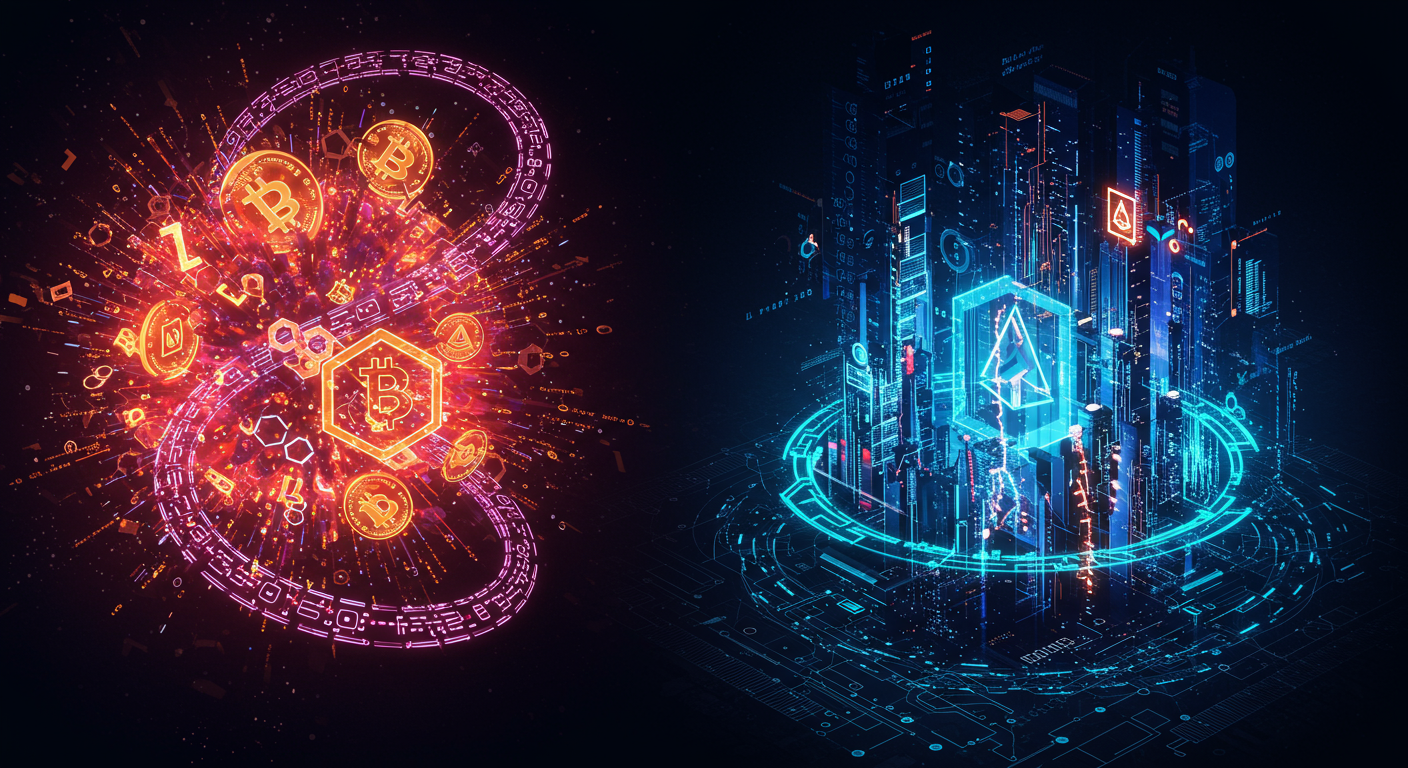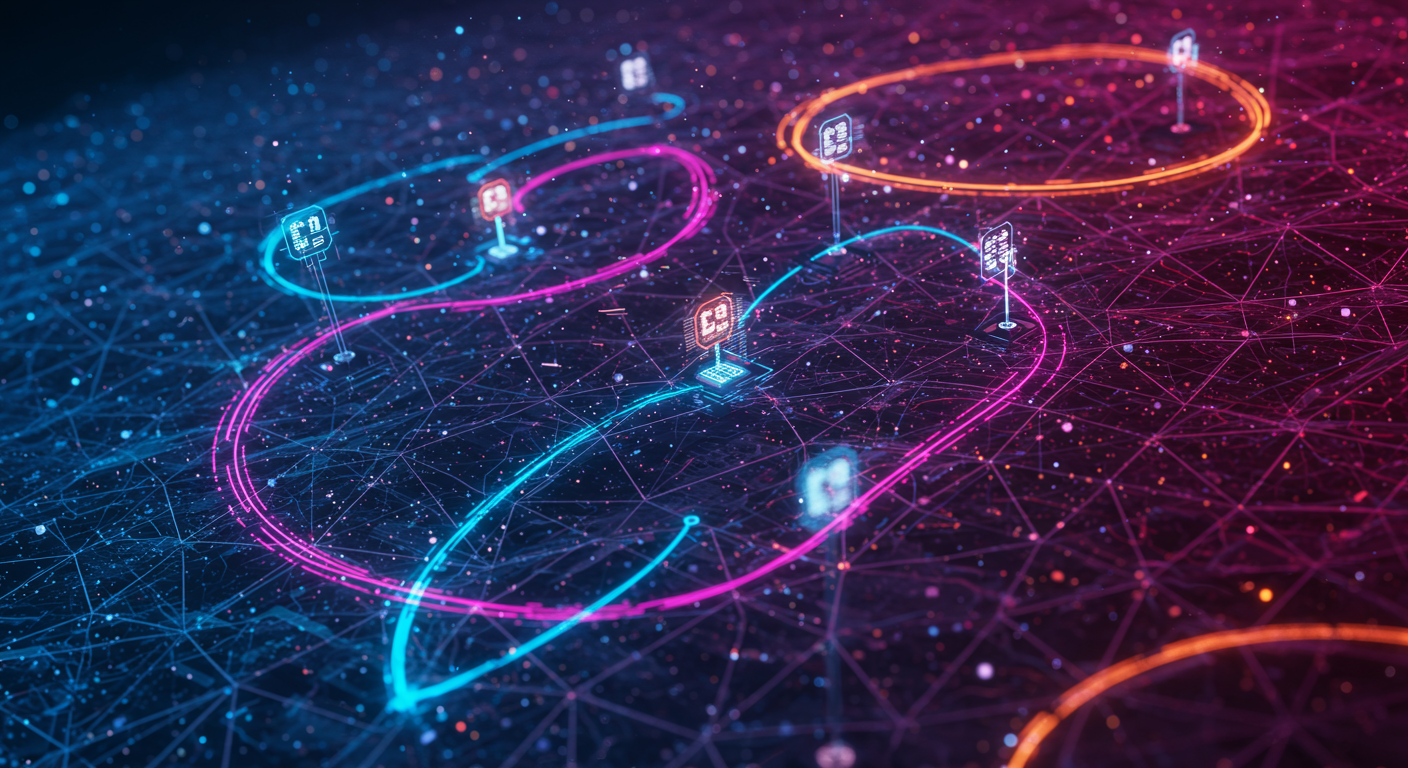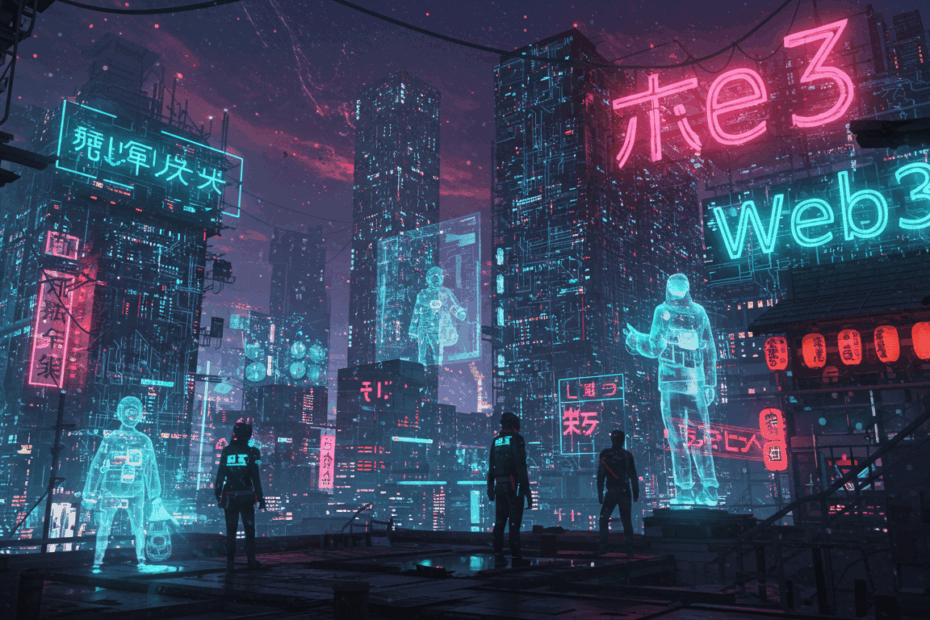The Unseen Engine: A Beginner’s Guide to Web3, Crypto Infrastructure, and the Future of the Metaverse
John: Welcome, everyone. When most people hear “Metaverse,” they picture futuristic avatars and sprawling virtual worlds. That’s the dazzling storefront. But today, Lila and I are going to take you into the engine room. We’re talking about the foundational technology that makes it all possible: the Web3 and crypto infrastructure. It’s not as flashy, but it’s where the real revolution is happening. This is the bedrock upon which every decentralized experience will be built.
Lila: That’s a great way to put it, John. It feels like we’re talking about the plumbing and electricity of a new kind of city. Most people just want to live in the cool apartments, but someone has to build the foundation. So, for someone totally new to this, what’s the big deal? Why do we need this whole new “Web3” thing anyway? What was wrong with the internet we already have?

So, What is Web3, Exactly?
John: An excellent starting point. The internet has evolved in stages. Think of it like this:
- Web1 (The 1990s): This was the “read-only” internet. It was mostly static web pages, like a giant digital library. You could consume information, but you couldn’t really interact or create much.
- Web2 (The 2000s to Today): This is the “read-write” internet, the age of social media and user-generated content. We can create, share, and interact. The problem is that this interaction is controlled by a handful of large corporations. They own our data, control the platforms, and set the rules.
- Web3 (Now and the Future): This is the “read-write-own” internet. It’s about taking back control. By using decentralized technologies like blockchain, Web3 aims to build an internet where users, not corporations, own their data, their digital assets, and even their online identities.
Lila: Okay, “read-write-own” is a really clear way to frame it. So, instead of my profile on a social media site belonging to the company, in Web3, it would actually belong to *me*? And the infrastructure is what makes that ownership provable and secure?
John: Precisely. That proof and security come from the crypto infrastructure, which is the collection of technologies that powers Web3. It’s the digital equivalent of property rights, enforced by code instead of courts.
The Core Components: Demystifying Crypto Infrastructure
Lila: Let’s get into the nitty-gritty then. When we say “crypto infrastructure,” it sounds super technical. Can you break down the main parts for us? What are the essential cogs in this machine?
John: Of course. At its heart, the infrastructure consists of a few key layers. The most fundamental is the blockchain (a shared, unchangeable digital ledger). Think of it as a global, transparent, and tamper-proof public record book. Every transaction, whether it’s sending money or creating a digital item for a game, is recorded as a “block” and added to a “chain” that everyone can see.
Lila: So, no single person or company can go back and secretly change the records because the book is being watched by thousands of people at once. I get that. What sits on top of this blockchain record book?
John: On top of the blockchain, you have smart contracts (self-executing contracts with the terms of the agreement directly written into code). These are programs that run on the blockchain and automatically execute when certain conditions are met. For example, a smart contract could automatically release a payment to a freelance artist once a piece of digital art is delivered to a client’s wallet. It removes the need for a middleman, like a bank or a lawyer, to enforce the deal.
Lila: That sounds incredibly efficient! It’s like a vending machine for complex agreements. You put in the required input (the crypto), and the contract automatically gives you the output (the digital good or service). What else is in the toolkit?
John: Then you have the entire ecosystem that supports these functions. This includes things like nodes (the individual computers that maintain the blockchain network), APIs or Application Programming Interfaces (tools that allow different applications to talk to the blockchain without needing to understand all its complexities), and oracles (services that feed real-world data, like stock prices or weather information, into the blockchain for smart contracts to use).
Lila: So oracles are the bridge between the digital blockchain world and our physical world. Without them, the smart contracts would be stuck in their own little universe, unable to react to real-life events. This whole system seems deeply interconnected. It’s a whole new digital infrastructure, just as the search results suggest, designed for transparency and security.
The Building Blocks: A Closer Look at the Technology
The Foundation: Layer 1 (L1) Blockchains
John: Exactly. And this infrastructure is built in layers, much like a skyscraper. The ground floor is what we call Layer 1 (L1). These are the main, foundational blockchains that handle all the transaction processing and data security themselves. Bitcoin and Ethereum are the most famous examples. They are the ultimate source of truth and security for their respective ecosystems.
Lila: I’ve heard people say that using Bitcoin or Ethereum can sometimes be slow and expensive, especially when lots of people are using it. Is that the downside of being the main foundation?
John: You’ve hit on a core challenge in the blockchain world, often called the “Blockchain Trilemma.” A network struggles to be simultaneously:
- Decentralized: Run by many participants, not a single entity.
- Secure: Resistant to attack and fraud.
- Scalable: Able to handle a high volume of transactions quickly and cheaply.
L1 chains like Ethereum prioritize decentralization and security, which historically has meant sacrificing some scalability. This is why we’ve seen such a surge in L2 innovation.
Scaling Up: The Role of Layer 2 (L2) Solutions
Lila: So, what are these L2 innovations? Are they like building an express highway on top of the main city streets to ease traffic?
John: That’s a perfect analogy. A Layer 2 (L2) is a secondary protocol built on top of an L1. It processes transactions “off-chain” in its own faster, cheaper environment. It bundles hundreds or even thousands of these transactions together and then submits a single, compressed proof of them back to the main L1 chain. This way, it inherits the security of the L1 while offering the speed and low cost needed for applications like gaming or frequent small payments.
Lila: Ah, so projects like Polygon, Arbitrum, and Optimism aren’t trying to replace Ethereum, they’re trying to help it. They handle the high-speed traffic on the expressways, but still rely on the L1’s main roads for final security and settlement. This makes dApp prototyping and development much more practical for businesses, as they can build without worrying about massive fees for every little interaction.
John: Correct. This L1 and L2 infrastructure is a modular approach that allows for specialization. The L1 provides a robust, decentralized settlement layer, while L2s provide the execution environments where the bulk of user activity can happen. This is a critical technological breakthrough for the crypto market.

Powering the New Economy: Tokenization and Digital Assets
More Than Just Money: The Concept of Tokenization
John: This robust infrastructure unlocks a powerful concept: tokenization. This is the process of converting rights to an asset into a digital token on a blockchain. We’re not just talking about cryptocurrencies like Bitcoin. We’re talking about representing ownership of almost anything of value.
Lila: So you could tokenize a house? Instead of a paper deed, you’d have a digital token in your wallet representing your ownership? What else can be tokenized? The possibilities seem endless.
John: Exactly. You could tokenize:
- Real Estate: Fractional ownership of a building, allowing smaller investors to participate.
- Art: Proving provenance and allowing for shared ownership of a masterpiece.
- Intellectual Property: Royalties from a song could be tokenized and distributed automatically to token holders via a smart contract.
- Identity: A self-sovereign identity where you control your personal data and grant access on a case-by-case basis.
- In-game Assets: That rare sword you won in a Metaverse game? Tokenize it. It becomes a verifiable asset you truly own and can sell or trade on any compatible marketplace, not just within the game itself.
This is what articles mean when they talk about Web3 building an “inclusive digital economy.” It brings liquidity and accessibility to previously illiquid assets.
Supply and Demand in a Decentralized World
Lila: This brings up the “supply” part. With traditional money, a central bank controls the supply. How does that work in Web3? Who decides how many tokens for a project exist? And how do we trust that?
John: This is governed by tokenomics (the economics of a crypto-token). For most projects, the rules of supply are coded directly into the protocol from the very beginning and are publicly visible on the blockchain. For example, Bitcoin has a hard cap of 21 million coins that will ever be created. The release schedule is predetermined and unchangeable.
Lila: So the transparency of the blockchain infrastructure itself provides the trust. You don’t have to trust a person or a government not to print more money and devalue your holdings; you just have to trust the code, which everyone can inspect. That’s a radical shift.
John: It is. For other projects, the supply might be managed by a DAO, a decentralized community, but the rules are still enforced by smart contracts. This programmatic scarcity and transparent governance are key innovations designed to create predictable and fair economic systems.
The Architects and Builders: Teams and Communities in Web3
Beyond the Corporation: The Rise of DAOs
Lila: You just mentioned DAOs. I see that acronym everywhere. It stands for Decentralized Autonomous Organization, but what does that actually mean in practice? How can an organization be “autonomous”?
John: A DAO is essentially an organization run by code and community. Think of it as a company with no CEO or traditional management structure. The rules of the organization are encoded in smart contracts. Key decisions—like how to spend treasury funds or what features to develop next—are made through proposals and voting by members who hold the DAO’s governance tokens.
Lila: So your “share” in the company is a token that gives you a vote. It’s like a digital co-op, where the users and builders are also the owners and decision-makers. That sounds like a powerful way to align incentives and foster a strong community.
The Power of Open Source
John: It is, and it ties directly into another core ethos of Web3: it’s overwhelmingly open source. The code for most protocols, dApps, and infrastructure projects is public. This fosters a culture of collaboration over competition. Developers can freely inspect, audit, and build upon each other’s work. It’s a key reason why we see such rapid DApp prototyping and innovation in the space. Someone can build a great financial primitive, and someone else can immediately integrate it into their new gaming platform, creating what we call “money legos.”
Lila: That’s a huge contrast to the walled gardens of Web2, where companies keep their code and data proprietary to maintain a competitive edge. Here, the innovation is shared, which probably accelerates the growth of the entire ecosystem. It explains why we see so many new open-source Web3 projects emerging all the time.
From Theory to Reality: Use Cases and Future Outlook

John: Precisely. And this accelerated innovation is leading to tangible use cases. The most mature is Decentralized Finance (DeFi). It aims to rebuild the entire traditional financial system—lending, borrowing, trading, insurance—on open, decentralized rails, without the need for banks.
Lila: So I could theoretically take out a loan or earn interest on my assets without ever filling out a form at a bank, just by interacting with a smart contract? That’s game-changing for financial inclusion.
John: That’s the goal. Of course, it’s still a new and volatile space. But the other massive area is, as we’ve touched on, Gaming and the Metaverse. Web3 infrastructure allows for true ownership of in-game items (as NFTs, or Non-Fungible Tokens), player-run economies, and interoperable assets that you can take from one virtual world to another.
Lila: As a gamer, that’s the most exciting part for me. The hours I spend earning an item in a game would translate into real, provable value. It changes the dynamic from being a simple consumer of the game to being a stakeholder in its economy.
John: And looking forward, the next great frontier is interoperability. The future isn’t one blockchain to rule them all. It’s a multi-chain world where value and data can flow seamlessly between different networks like Ethereum, Solana, and others. Innovations in cross-chain bridges and protocols are making this a reality. It’s building the true, interconnected internet of value.
The Competitive Landscape: Ethereum vs. The Rest
Lila: You mentioned a multi-chain world. For a developer or a business looking to build, how do they choose? What’s the difference between a major L1 like Ethereum and a challenger like Solana or NEAR Protocol?
John: It all comes back to the trilemma. Ethereum has historically prioritized decentralization and security. It has the largest community, the most battle-tested security, and the most developer activity, but it has faced scalability challenges, which L2s are now solving.
Lila: So Ethereum is like the established, bustling but sometimes congested, capital city.
John: A fair analogy. Then you have chains like Solana, which was built from the ground up for high performance and speed. It uses a different consensus mechanism (Proof-of-History) to achieve very high transaction throughput and low fees on its L1. The trade-off is that it’s arguably less decentralized than Ethereum, with higher hardware requirements to run a node.
Lila: So Solana is more like a brand-new, hyper-modern city designed with massive superhighways from the start, but perhaps with a more centralized city planning committee.
John: Exactly. And there are many others, like NEAR Protocol, which focuses on usability for developers, or Avalanche with its subnets. There isn’t a single “best” one. The right choice depends on the specific needs of the application. Does it need maximum security for high-value financial transactions, or does it need lightning speed for a fast-paced game? The diversity of this L1 and L2 infrastructure is a sign of a healthy, maturing market.
Navigating the Frontier: Risks and Cautions
John: Now, we have to be realistic. This is still a frontier technology, and with great innovation comes significant risk. The three biggest areas of concern are:
- Security: While blockchains themselves are very secure, the smart contracts built on top of them can have bugs or vulnerabilities that hackers can exploit. We’ve seen billions of dollars lost to these exploits.
- Regulatory Uncertainty: Governments around the world are still trying to figure out how to regulate this new asset class and technology. Future laws could significantly impact the market.
- Volatility: The value of crypto assets is famously volatile. This is not a space for the faint of heart or for investing money you cannot afford to lose.
Lila: Those are serious concerns. So for a newcomer who’s excited by the potential but wary of the risks, what’s the best advice? How can they stay safe while exploring?
John: Education is paramount. Start small. Never share your private keys or seed phrase with anyone. Be skeptical of “too good to be true” promises of high returns. Use hardware wallets for significant holdings. And always, always do your own research (DYOR) on any project before interacting with it. Look at the team, the community, the transparency of the code, and what problem it’s genuinely trying to solve.
Voices from the Field: Expert Opinions and Analyses
Lila: I was reading about Aztec Amaya, the strategist behind projects like Polygon and LitVM. He seems to be a big proponent of “utility-driven innovation.” What does that mean in this context?
John: It means focusing on building infrastructure and applications that solve real-world problems, rather than just speculating on token prices. Amaya’s perspective is that the long-term value of Web3 will come from its utility—its ability to make things more efficient, transparent, or fair. This is a sentiment echoed across the industry by serious builders. They see crypto infrastructure as the engine for new business models and services, from decentralized AI, like the PromptChain architecture which turns AI prompts into ownable digital assets, to revolutionizing supply chain management.
Lila: So the hype is temporary, but the utility is permanent. The real measure of success for this technology will be how many people are using it because it offers them a better service, not just because they hope its token price will go up.
John: That’s the core of it. The conversation is shifting from price to product, from speculation to application. That’s a sign of maturity.
What’s Next? Latest News and Roadmap
John: The pace of innovation is relentless. A few key trends are defining the current roadmap for Web3. One is the deeper integration of Artificial Intelligence. We’re seeing projects build on-chain AI agents and decentralized machine learning models, creating transparent and verifiable AI systems.
Lila: AI and Web3 together? That sounds like a powerful combination! You could have AI that’s owned by a community (a DAO), not a corporation, with its decision-making processes being totally transparent on the blockchain. The implications are staggering.
John: They are. Another major focus is the tokenization of Real-World Assets (RWAs). This is the effort to bring trillions of dollars of assets, from real estate to private credit, onto the blockchain. It’s seen as the next major bridge between DeFi and the traditional economy. Finally, we’re seeing continuous innovation in the core infrastructure itself, with protocols like EigenLayer introducing new concepts like “restaking” to enhance security and capital efficiency across the ecosystem.
Lila: It feels like the foundational layers are getting stronger and more efficient, while the range of things being built on top is expanding exponentially from digital-native ideas to tangible, real-world applications. The future isn’t just coming, it’s being actively coded.
Frequently Asked Questions (FAQ)
Lila: Let’s wrap up with a few common questions I hear all the time. First up: Isn’t crypto just for speculation and a tool for criminals?
John: That’s an early narrative that’s hard to shake. While speculation is certainly a part of the market, the underlying crypto infrastructure is a powerful technology for secure data and value transfer. Its transparency actually makes it a poor choice for illicit activities in the long run, as transactions are permanently recorded on a public ledger. The focus for builders is now squarely on utility, as we’ve discussed.
Lila: Next: Do I need to be a coder or a tech genius to use Web3?
John: Not anymore. In the early days, yes. But a major focus now is on improving the user experience. New wallets are becoming much more user-friendly, and dApps are getting easier to navigate. The goal is to make the underlying technology invisible, just as you don’t need to understand TCP/IP to browse a website today.
Lila: Good to hear! How about this one: What’s the difference between Web3 and the Metaverse?
John: It’s a great question. The Metaverse is the “what”—the vision of interconnected, persistent virtual worlds and experiences. Web3 is the “how”—the decentralized infrastructure of blockchains, smart contracts, and tokens that will allow the Metaverse to be open, interoperable, and owned by its users, rather than by a single company.
Lila: And finally: How is Web3 more secure if I’m always hearing about hacks?
John: This is a crucial distinction. The core blockchain protocols themselves have proven to be incredibly secure. The weak points are typically the applications built on top (the dApps) or user-level security (people getting phished). The industry is heavily focused on improving security audits for dApps and creating better security tools for users. It’s a maturing process, much like the early days of the commercial internet.
Final Thoughts and Further Reading
John: We’ve covered a lot of ground today, from the basic definition of Web3 to the complex layers of its infrastructure and its future potential. The key takeaway is this: behind the headlines and the market fluctuations, a dedicated global community is building a more transparent, user-owned, and innovative digital world. The crypto infrastructure they’re laying down today will be the invisible foundation for the applications we’ll all be using tomorrow.
Lila: It’s a lot to take in, but it’s genuinely exciting. It feels like we’re at the dawn of a new technological paradigm. Thanks for breaking it all down, John.
John: My pleasure, Lila. For anyone looking to learn more, I recommend exploring resources like Ethereum.org, a16z crypto’s research hub, and publications like Decrypt and The Defiant.
Disclaimer: This article is for informational purposes only and should not be construed as financial advice. The crypto market is highly volatile. Please do your own research (DYOR) before making any investment decisions.
Related Links
- What is Web3? – by Ethereum.org
- a16z crypto Canon – A Reading List for Web3
- Decrypt – News and Education on Bitcoin & Web3
